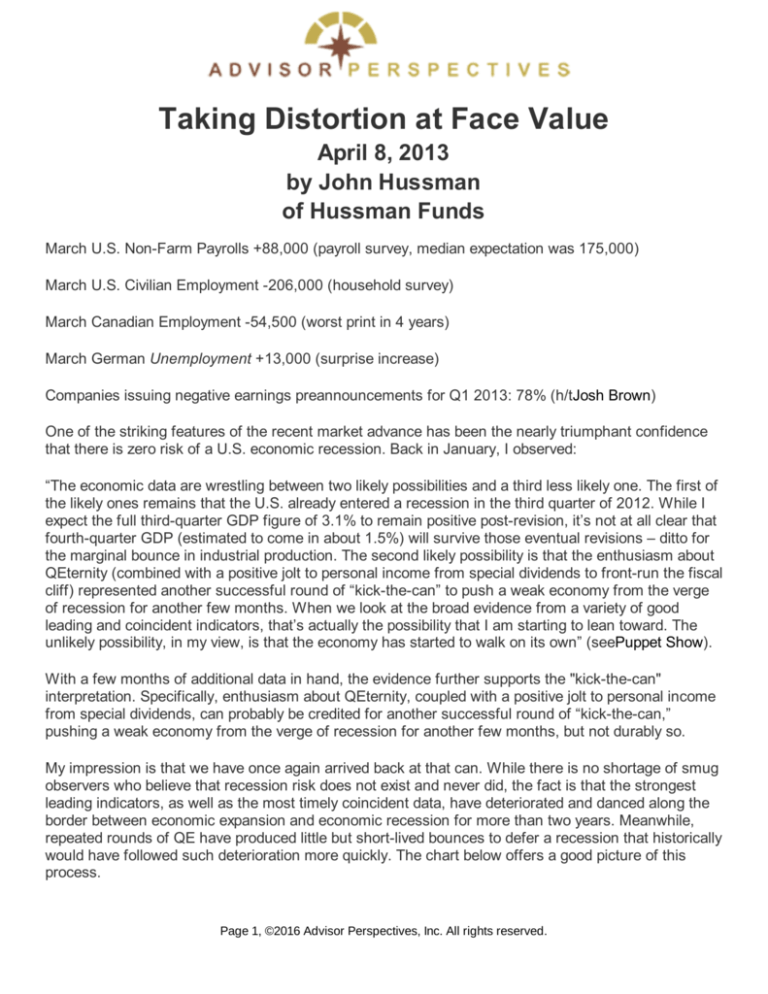
Taking Distortion at Face Value
April 8, 2013
by John Hussman
of Hussman Funds
March U.S. Non-Farm Payrolls +88,000 (payroll survey, median expectation was 175,000)
March U.S. Civilian Employment -206,000 (household survey)
March Canadian Employment -54,500 (worst print in 4 years)
March German Unemployment +13,000 (surprise increase)
Companies issuing negative earnings preannouncements for Q1 2013: 78% (h/tJosh Brown)
One of the striking features of the recent market advance has been the nearly triumphant confidence
that there is zero risk of a U.S. economic recession. Back in January, I observed:
“The economic data are wrestling between two likely possibilities and a third less likely one. The first of
the likely ones remains that the U.S. already entered a recession in the third quarter of 2012. While I
expect the full third-quarter GDP figure of 3.1% to remain positive post-revision, it’s not at all clear that
fourth-quarter GDP (estimated to come in about 1.5%) will survive those eventual revisions – ditto for
the marginal bounce in industrial production. The second likely possibility is that the enthusiasm about
QEternity (combined with a positive jolt to personal income from special dividends to front-run the fiscal
cliff) represented another successful round of “kick-the-can” to push a weak economy from the verge
of recession for another few months. When we look at the broad evidence from a variety of good
leading and coincident indicators, that’s actually the possibility that I am starting to lean toward. The
unlikely possibility, in my view, is that the economy has started to walk on its own” (seePuppet Show).
With a few months of additional data in hand, the evidence further supports the "kick-the-can"
interpretation. Specifically, enthusiasm about QEternity, coupled with a positive jolt to personal income
from special dividends, can probably be credited for another successful round of “kick-the-can,”
pushing a weak economy from the verge of recession for another few months, but not durably so.
My impression is that we have once again arrived back at that can. While there is no shortage of smug
observers who believe that recession risk does not exist and never did, the fact is that the strongest
leading indicators, as well as the most timely coincident data, have deteriorated and danced along the
border between economic expansion and economic recession for more than two years. Meanwhile,
repeated rounds of QE have produced little but short-lived bounces to defer a recession that historically
would have followed such deterioration more quickly. The chart below offers a good picture of this
process.
Page 1, ©2016 Advisor Perspectives, Inc. All rights reserved.
Notice the successively lower levels, as each round of quantitative easing has smaller and smaller
effects on real economic activity (speculative activity in the financial markets aside). The question at
present is whether the recent bounce will prove to be temporary as well. This expectation is certainly
consistent with the series of rapid-fire misses from the Chicago Purchasing Managers Index
(particularly the new orders component), the national PMI reports for both manufacturing and services,
and the unexpected weakness on both payroll and household employment surveys.
For my part, I continue to expect the U.S. economy to join a global recession that is already in progress
in much of the developed world (assuming a U.S. recession has not already started, which we can’t
rule out, but would require knowledge of eventual data revisions to confirm). Suffice it to say that the
realistic case for a sustained economic expansion here remains terribly thin.
While some observers will reflexively point to the housing market as a sign of economic recovery, it is
important to recognize that the millions of homeowners with underwater mortgages (home values
below the amount of mortgage debt still owed) have no ability to sell their homes even if they wish to do
so, unless they can come up with the difference out of pocket. As a result, the natural flow of demand
from new household formation must be satisfied from an inventory of homes for sale that is much
Page 2, ©2016 Advisor Perspectives, Inc. All rights reserved.
smaller than the actual “shadow inventory” that would be available if losses did not have to be taken in
order to sell those homes. So the demand for homes resulting from household formation is satisfied
from limited inventory plus new home building, even though there is an ocean of distressed and unsold
homes already in existence. From this perspective, it should be clear that the bounce we’ve seen in
housing is not a sign of economic recovery, but is instead a sign of misallocation of capital due to what
economists would generally call a “market failure.”
Taking Distortion at Face Value
On the earnings front, my concern continues to be that investors don’t seem to recognize that profit
margins are more than 70% above their historical norms, nor the extent to which this surplus is the
direct result of a historic (and unsustainable) deficit in the sum of government and household savings
(seeTwo Myths and A Legendfor an analysis, including more than a half-century of data on this). As a
result, investors seem oblivious to the likelihood of earnings disappointments not only in coming
quarters, but in the next several years. We continue to expect this disappointment to amount to a
contraction in earnings over the next 4 years at a rate of roughly 12% annually.
Despite the enormous weight of both accounting identity, historical data, and simple arithmetic, we
Page 3, ©2016 Advisor Perspectives, Inc. All rights reserved.
continue to encounter persistent hostility to the idea that profit margins are the mirror image of
extraordinary and unsustainable deficits in the government and household sector. The actual
relationship was first detailed by the economist Michal Kalecki in the mid-1900’s.James Montierof
GMO gives a nice derivation. The full relationship is:
Profits = Investment – Household Savings – Government Savings – Foreign Savings + Dividends
As I noted over a year ago, dividends exhibit very little volatility over time, and do not exert a material
amount of volatility in the above relationship over the course of the economic cycle. It also happens
that particularly in U.S. data, the difference between Investment and Foreign Savings (i.e. the inverse
of the current account deficit) also fluctuates relatively little, because current account “improvement” is
typically associated with deterioration in gross domestic investment, as shown below in data since the
1940's.
As a result, the Kalecki equation reduces, for all practical purposes, to a statement that
Page 4, ©2016 Advisor Perspectives, Inc. All rights reserved.
corporate profits move opposite to the sum of household and government saving. Again,
seeTwo Myths and A Legendmore than a half-century of data that demonstrates the tightness of this
relationship.
The upshot is very simple, the U.S. stock market presently reflects two unstable features. One is that
extraordinary monetary policy – specifically quantitative easing – has created an ocean of zero-interest
money that someone has to hold at each point in time, and that provokes a speculative reach for yield.
The other is that extraordinary fiscal policy, coupled with household savings near record lows, have
joined to elevate profit margins more than 70% above their historical norm, as the deficit of one sector
has to emerge as the surplus of another. The result is that investors quite erroneously accept the
distorted “earnings yield” of stocks (and the associated “forward price/earnings multiple” of the S&P
500) at face value, without any adjustment for elevated profit margins or the historical tendency for
such elevations to be eliminated over the course of the business cycle.
Put simply, stocks are not cheap, but are instead strenuously overvalued. The speculative reach for
yield, encouraged by the Federal Reserve, has created another bubble – which is not recognized as a
bubble only because distorted profit margins create the illusion that stocks are reasonably valued. We
presently estimate a prospective 10-year nominal total return for the S&P 500 of less than 3.5%
annually. The likelihood of even this return being achieved smoothly, without severe intervening
volatility and steep market losses, is roughly zero. This does not imply or ensure immediate market
losses, but it doesn’t need to. On any horizon of less than about 6-7 years, we expect that any
intervening returns achieved by the S&P 500 will be wiped out, and then some. Speculate if you believe
that your exit strategy will dominate that of millions of other speculators, despite market conditions that
are already overvalued, overbought, overbullish. In my view, all of this will end badly.
© Hussman Funds
www.hussman.net
Page 5, ©2016 Advisor Perspectives, Inc. All rights reserved.












